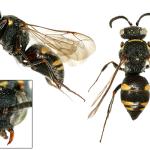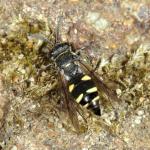Nysson nigripes Spinola, 1808; Nysson geniculatus Olivier, 1812
A species of Nysson that apparently has two hosts in this country and is sometimes easier to locate than its hosts.
Recorded widely in the southern half of England, from Cornwall to Kent and north to Warwickshire and Yorkshire; also the Channel Islands. Abroad, rare but widely distributed in Europe; also Japan (Lomholdt, 1975-1976), and recently reported from China.
Listed as Notable B by Falk (1991) [now known as Nationally Scarce (Nb)], and clearly scarcer than its hosts in most parts of the country, though it has been noted as relatively frequent in Kent, where it is sometimes easier to find than its host there, Gorytes bicinctus. It may have expanded its range northwards in recent decades and is now known from several Yorkshire sites, a county from which it was unrecorded prior to the 1970s.
Recorded from a variety of open habitats on light soils, including heathland, dry grassland and scrub, open woodland, coastal landslips and soft rock cliffs, quarries and other post-industrial sites and occasionally heavily urbanised locations. Three specimens were even obtained from a roadside hedge in central London (K M Guichard, pers. obs.). Usually observed running on sparsely-vegetated ground or low herbage.
Early June to early September.
Specimens have occasionally been observed running over sycamore (Acer pseudoplatanus) leaves, presumably attracted by honeydew (G R Else, pers. comm.). In France, Bitsch et al. (1997) mention the inflorescences of Apiaceae.
No information available.
Proofed: March 2012



